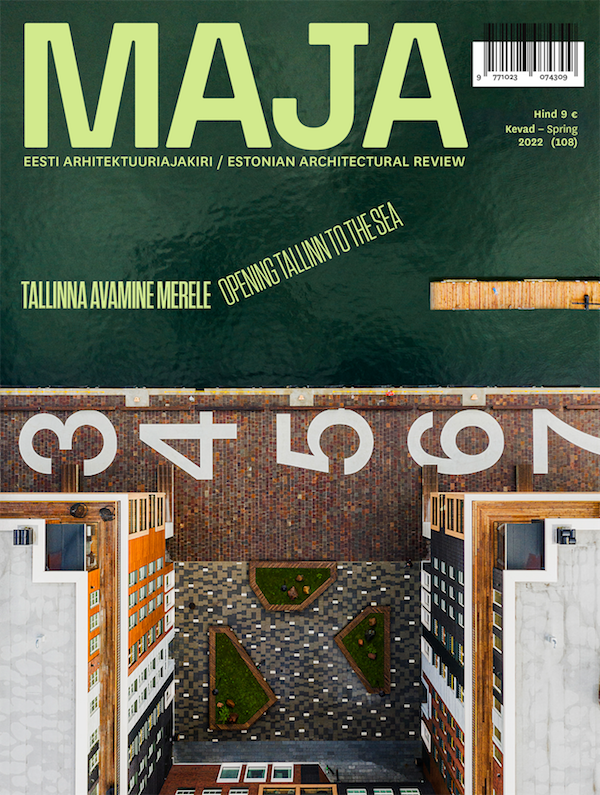Rotermann. The City of Houses 〉Mattias Malk
Rotermann Quarter 20 years later 〉Mathilda Viigimäe, Kristi Tšernilovski
The Industrial Heritage of Tallinn Set for A New Lease of Life 〉Henry Kuningas
In the Winds of Gentrification – The Noblessner Quarter 〉Hannes Aava
From Submarines to Bicycles: The Story of Noblessner 〉Pärtel-Peeter Pere
Kalaranna Quarter – One Step Back, Two Steps Forwards 〉Endrik Mänd
Who Hacks the City? 〉Johanna Holvandus
Remarks on Kalarand 〉Questions by Johanna Holvandus
North-Tallinn fits a Tartu-full of People 〉Urmo Mets
Spatial Design at Põhja-Tallinn 〉Jaak Adam Looveer, Anna Semjonova, Mihkel Kõrvits
A (Sustainable, Healthy, Innovative, Creative, Diverse, and Lively) City 〉Leonard Ma
Tallinn’s Long Journey to the Sea
The current year is a good time for an interim summary of how the seaside developments in Tallinn have progressed, as Kalaranna District will be completed, and Noblessner, which has enjoyed exceptional popularity already for several years, is also taking shape. Furthermore, twenty years have passed since the birth of the spatial development plan that led to the revival of one of the architecturally most ambitious environments in Estonia―the Rotermann Quarter, where the final building (Roseni Office Building) is now also being built.
These are the seafronts in Tallinn that have received the most attention. They have been heatedly and thoroughly debated, to the extent of becoming kind of textbook examples that were constantly newsworthy even in the restless noughties and 2010s, when living environment was not generally prioritised as a topic in public discussions. Emergence of Rotermann, Noblessner and Kalaranna District has significantly shaped how we think of public urban space and industrial heritage. In the process, planning practices and the role of civic activism have also been transformed.
Tallinn has made an arduous, almost 100-year journey to the sea, in the course of which urban development plans and actual deeds have proven to be inconsistent. In the 19th and 20th century, the seafront was allocated to industrial and harbour buildings rather than lively city streets. The 1912 project of Greater Tallinn by Eliel Saarinen likewise foresaw the seaside part of the city centre accommodating production activities and a closed harbour area. Soviet-era general plans described Tallinn as a maritime city, but this description found a modest expression on the ground only in 1980, in connection with construction for the Summer Olympics sailing event. After the end of the Soviet period it took about a decade before the seafront and its industrial heritage came back on the agenda. But Tallinn’s untapped potential―possibility of establishing a seaside city centre―was increasingly discussed, and the only structure plan―a development plan detailing specific spatial outputs―approved by Tallinn City Council (in 2007) focused namely on the development of a seaside city. Thus, ‘opening Tallinn up to the sea’ became the only urban development vision steering the city through the gusts of neoliberalism in the frantic ‘00s and ‘10s.
I am writing these lines while sitting in an outdoor cafe at Rotermann Square. Over twenty years, this former industrial district has changed beyond recognition. Back when it was still a partly ruined quarter, it used to fuel my imagination―what would become of it, what kind of life is going to be lived here? What activities, causes and dreams once shaped this space and found a home here? This is precisely what an expressive space does―it gives birth to imagination and leads one on a mental journey. The dense and disordered labyrinth formed by manifold erstwhile industrial buildings in Rotermann also speaks to people today and inspires them. A space that has been designed (or ‘solved’) on the basis of generic declarative principles does not speak. There are various contradictions and conflicts smouldering between different historical layers. Juxtaposing and explicating them gives voice to societies of different eras; the contradictions excite, disillusionise and keep one focused on what is specific. In the same way, the spatial elaboration of smouldering between modern uses makes diferent members of society audible and visible.
We do not really understand what it takes for the authenticity or milieu of a place to survive. Does it suffice to merely preserve what is old and perhaps even crumbling, and to contrast layers from different eras? How to retain the unique functions, peculiarities and uses of a place, and how to create them? The sight of Tallinn’s unfinished waterfront, replete with construction cranes, instills a good feeling―there is still much here that has not become predictable and sleek, and authentic daily activities are still going on. But will there still be room for imagination once the construction cranes are gone?
In Põhja-Tallinn, many former industrial and/or seafront areas are being developed and redesigned. The area is rich in long-preserved everyday spaces and practices. Now it is up to us whether the waves of gentrification and generification wash over the whole of Põhja-Tallinn, or whether we are able appreciate the authenticity and richness of the space in some better way. This depends on how much we can learn from the failures and successes of Rotermann, Noblessner and Kalaranna, and understand the sort of quality experience that they offer.
Editor-in-chief Kaja Pae
May, 2022





